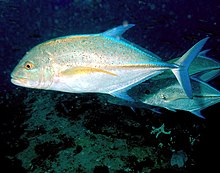
Back شيميات الشكل Arabic شيميات الشكل ARZ Stachelmakrelenverwandte German گیشماهیسانان Persian Carangiformes Croatian Carangiformes ID 전갱이목 Korean Carangiformes Dutch Ставридообразные Russian Bộ Cá khế Vietnamese
Parts of this article (those related to Reason:Carangiformes is still using Fishes of the world 5th ed (2016) which is noted to be conservative in aproach due to being completed posthumously after the author passed. Billfishes and other fish species within this order is following the more recent Eschmeyer's Catalog of Fishes Classification with adjustments for the broader definition found in paleontology liturature. What should happen is Carangiformes being updated to follow Eschmeyers expanded phylogeny of the order.
Reference: https://www.calacademy.org/scientists/catalog-of-fishes-classification/ ) need to be updated. (December 2024) |
| Carangiformes Temporal range:
| |
|---|---|

| |
| Bluefin trevally (Caranx melampygus) | |

| |
| Remora remora | |
| Scientific classification | |
| Domain: | Eukaryota |
| Kingdom: | Animalia |
| Phylum: | Chordata |
| Class: | Actinopterygii |
| Clade: | Percomorpha |
| Order: | Carangiformes Jordan, 1923[1] |
| Type species | |
| Caranx praeustus Anonymous [Bennett], 1830 | |
Carangiformes is an order of ray-finned fishes that is part of a sister clade to the Ovalentaria, the other orders in the clade being the Synbranchiformes, Anabantiformes, Istiophoriformes, and Pleuronectiformes. The Carangiformes have been long regarded as a monotypic order with only the family Carangidae within it by some authorities, and the other current families within the order have been previously classified as part of the wider order Perciformes. The 5th edition of Fishes of the World classify six families within Carangiformes,[2] with other authorities expanding the order to include up to 30 families.[3]
The earliest known carangiforms are two fossil species of Mene, Mene purydi from Peru and Mene phosphatica from Tunisia, both of which are known from the Late Paleocene.[4]
- ^ "Taxon: Order Carangiformes Jordan, 1923 (fish)". Taxonomicon. Retrieved 15 November 2019.
- ^ J. S. Nelson; T. C. Grande; M. V. H. Wilson (2016). Fishes of the World (5th ed.). Wiley. pp. 380–383. ISBN 978-1-118-34233-6. Archived from the original on 2019-04-08. Retrieved 2019-11-15.
- ^ Girard, Matthew G.; Davis, Matthew P.; Smith, W. Leo (2020-05-08). "The Phylogeny of Carangiform Fishes: Morphological and Genomic Investigations of a New Fish Clade". Copeia. 108 (2): 265. doi:10.1643/CI-19-320. ISSN 0045-8511.
- ^ Friedman, Matt; V. Andrews, James; Saad, Hadeel; El-Sayed, Sanaa (2023-06-16). "The Cretaceous–Paleogene transition in spiny-rayed fishes: surveying "Patterson's Gap" in the acanthomorph skeletal record André Dumont medalist lecture 2018". Geologica Belgica. doi:10.20341/gb.2023.002. ISSN 1374-8505.